
How to make homemade cream cheese from yogurt part 3
Tuesday 9th August 2011, Recipe 20110809
How to make homemade cream cheese from yogurt– an introduction
The last experiment for cream cheese on cheesecake was very sour and this time around I focused on the cheese making process. I believe I had solved most of the problems caused by the sour flavour. And you are lucky that I delay publishing this recipe by three days. On the day I made the cream cheese from yogurt, the taste was OK and at least it was not extremely sour. I did make it into a cheese cake and ate a sliced or two every day. Wonder of wonders, I found that the taste improved by the third day and it tasted like cream cheese. This is the first time I had seen, with my own eyes, homemade cheese ripen or mature and it did taste pretty good. In fact those who tasted it thought I had used store bought cream cheese until explained that it was made from yogurt. Even then, they thought that I had added yogurt into store bought cream cheese.
I knew that the most of the sour flavour was from the lactic acid in the yogurt. In order to neutralise the sourness I had to knock off the lactic acid at least a substantial part of it. Remembering by school chemistry, I know that an acid will react with a base to form salt and water. The sourness of the acid disappears and the saltiness of the salt presents itself plus there would be excess water.
The only chemical I had in my kitchen that could neutralise the lactic acid was baking soda. Baking soda is Sodium bicarbonate which when reacted with an acid will release carbon dioxide, water and the salt of the acid. My guess was that the salt of the acid would be Sodium lactate. I didn’t know whether sodium lactate would be green or purple or red in color and whether it would be poisonous. I checked the internet and all searchs showed that it was not poisonous. See Wikipedia on sodium lactate . According to Wikipedia “Sodium lactate has a mild saline taste and is commonly used in meat and poultry products to extend shelf life and increase food safety as it has a broad antimicrobial action, such as against yeast and fungi,[4] and is effective at inhibiting most spoilage and pathogenic bacteria.[6]”. Furthermore “As a food additive, sodium lactate has the E number E325 and naturally is a liquid product” and “is colourless, odourless, slightly viscous and slightly salty tasting and is stable with indefinite shelf life.”
That was great news. Sodium lactate would help me prevent fungal growth on my cheese. So far all my cheese experiments had failed due to black mushroom like fungal growth on the top of the cheese. Here was a promising solution to all my cream cheese making problems.
For those who are interested in the chemistry, I would hazard a guess that the reaction goes like this:-
CH3CHOHCOOH + NaHCO3 -> CH3CHOHCOONa + CO2 + H2O
Lactic acid + sodium bicarbonate -> sodium lactate + carbon dioxide + water
Do forgive me if my equation is wrong as I just wanted to show that gases, CO2 and water is released and we needed to watch out for the reaction and treat the cream cheese accordingly. I had used the acetic acid reaction with sodium bicarbonate equation to derive the lactic acid version – I really do have to brush up on my Rubber Technology Chemistry.
That was fun, wasn’t it? Just to help you out you can get books on cream cheese here.
The yogurt cream cheese recipe.
| Homemade yogurt cheese | ||||||
| Item | Ingredients | Percentage | Weight |
Weight |
||
|
(%) |
(g) |
oz. |
||||
|
1 |
Commercial Yoghurt |
100 |
1500 |
52.80 |
||
|
2 |
Vinegar | 2 tablespoons of vinegar | ||||
Photos of yogurt cream cheese making process
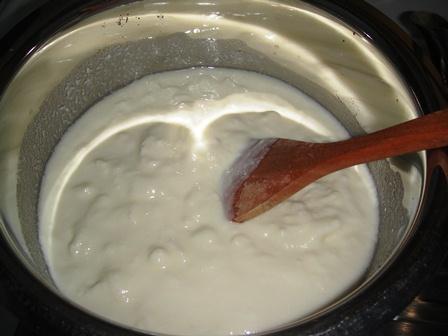
Pour the 1.5 kg of commercial yogurt into a pan and add one cup of water. Add two tablespoons of vinegar and stir well. I had decided to add the vinegar early so that it would have more time to ensure all the yogurt curdles.
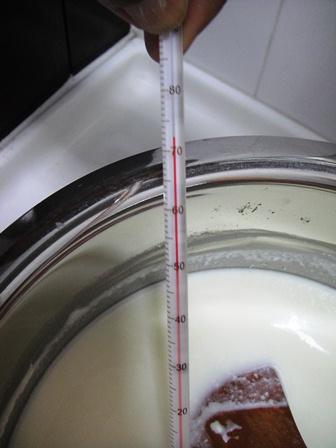
Use a small flame and heat the yogurt mixture until it comes to 70’C (158F). That took twenty minutes as I did not want the yogurt to boil. This is to destroy the live culture in the yogurt so that they will not carry on working when the yogurt is made into cheese. If bacteria were alive then the cream cheese would become sourer as it aged. You will notice that I had heated the mixture until 73C (163F). I kept it at this temperature for a few minutes before switching off the flame. I left it to cool for two hours.
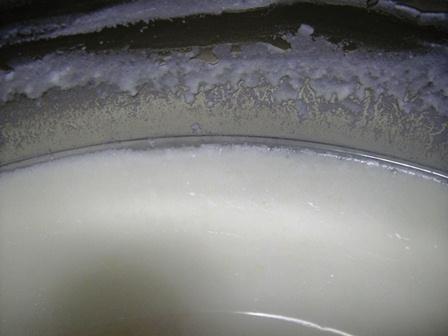
After two hours of cooling you can observe that the yogurt had curdled.
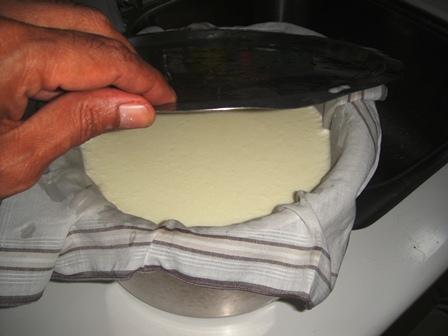
I poured the curdled yogurt into my strainer and allowed the whey to drain out overnight in the refrigerator. I had covered the strainer with a lid so that any fungus floating in the air would not settle on the yogurt.
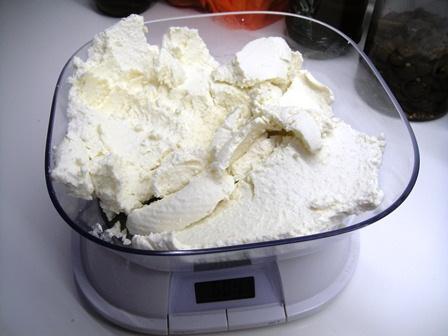
The next day I weighed the curd and found that there was 600 grams (21oz) of curd form 1.5kg (52.8oz)of commercial yogurt. Normally I would get about 500 grams (17.6oz) and I do not know whether this was due to the extra time for the vinegar to react or there is a batch to batch variation in the yogurt.
The yogurt cheese to cream cheese recipe
| Homemade cream cheese | ||||
| Item | Ingredients | Percentage | Weight | Weight |
|
(%) |
(g) |
oz. |
||
|
1 |
Yoghurt Cheese |
100 |
600 |
21.12 |
| baking soda |
2.5 |
15 |
0.53 |
|
|
2 |
Salt |
1 |
6 |
0.21 |
|
3 |
Icing Sugar |
15 |
90 |
3.17 |
|
4 |
Orange Concentrate |
5 |
30 |
1.0 |
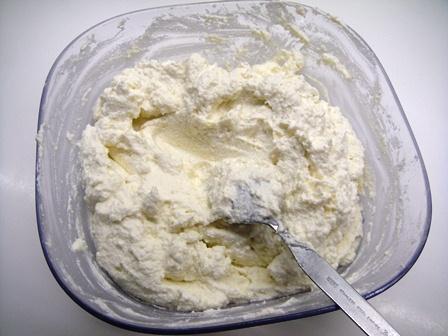
I added 2.5% baking soda (sodium bicarbonate) to the weight of the yogurt cream cheese, into the yogurt cream cheese and mixed it well.
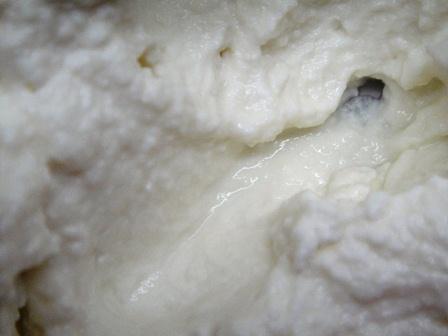
You will notice from the picture that there is one or two air vents – the two holes at the top of the picture, and you will notice water oozing out of the cheese – the center of the picture. That was wonderful as it confirmed that the sodium bicarbonate was reacting with the lactic acid. Unfortunately the cream cheese was becoming watery due to the chemical reaction releasing water into the cheese.
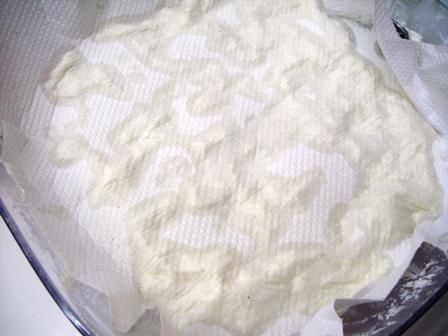
I used kitchen paper towel to absorb the water. I place the paper towels on top of the cream cheese. The paper towels can absorb quite a lot of water but I do not know whether this is the best process as I do not know whether the paper towels are hygienic enough to come in contact with food. But it worked.
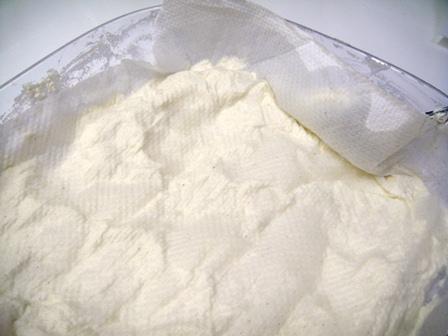
The paper towels absorbed so much water that every part of the paper towel was soaked in water. You could literally squeeze out water from the paper towels. I repeated this process seven times, that is, I used seven paper towels to remove excess water. Before each time I put the paper towel on top I had stirred the cheese to bring the wet cream cheese to the top. By the time I used the seventh paper towel the cream cheese was thick and stiff.
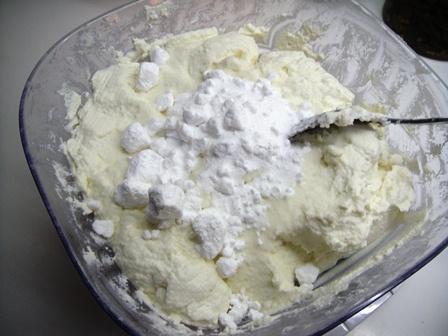
There still was a mild sour taste and for that reason I have added the icing sugar and salt. The orange concentrate is for the cream cheesecake I was making. At this stage the flavour of the cream cheese is just about OK but wait another three days and it will taste just like cream cheese at half the cost.
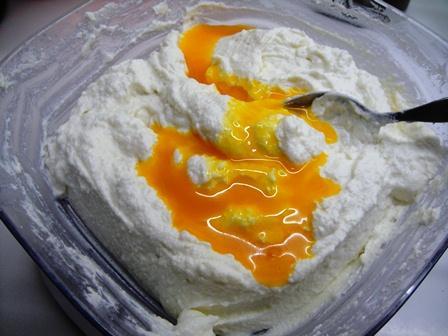
When I added the orange concentrate the cream cheese did not soften or go watery. It was still stiff like whipped cream.
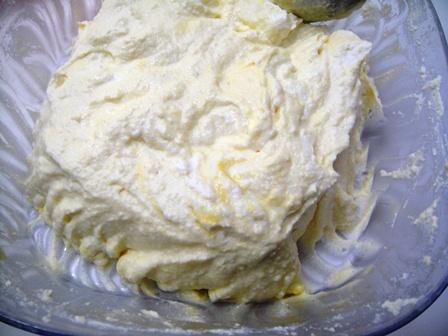
You can see how stiff the yogurt cream cheese was.
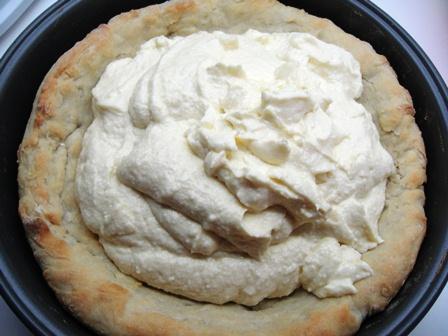
I dumped the whole yogurt cream cheese onto my pastry. You can see how stiff it is.
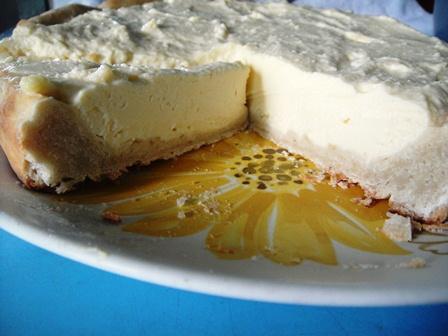
Here is the finished yogurt cream cheese cake after 3 days in the refrigerator. It matured very well and for a homemade cream cheese, was really creamy, almost like the real thing. My pastry needs a lot of improvement though.
This article “How to make homemade cream cheese from yogurt part 3” was researched and written by Peter Achutha
Leave a Reply